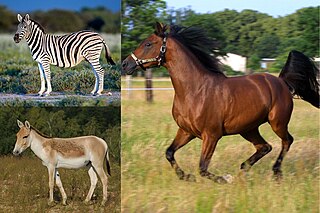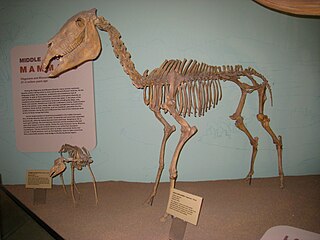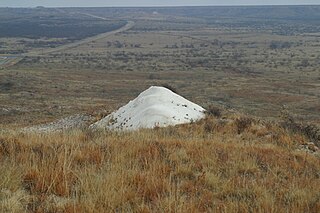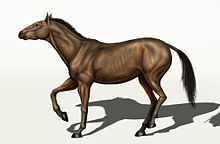
Equidae is the taxonomic family of horses and related animals, including the extant horses, asses, and zebras, and many other species known only from fossils. The family evolved around 50 million years ago from a small, multi-toed ungulate into larger, single-toed animals. All extant species are in the genus Equus, which originated in North America. Equidae belongs to the order Perissodactyla, which includes the extant tapirs and rhinoceros, and several extinct families.

Merychippus is an extinct proto-horse of the family Equidae that was endemic to North America during the Miocene, 15.97–5.33 million years ago. It had three toes on each foot and is the first horse known to have grazed.

Equus is a genus of mammals in the family Equidae, which includes horses, asses, and zebras. Within the Equidae, Equus is the only recognized extant genus, comprising seven living species. Like Equidae more broadly, Equus has numerous extinct species known only from fossils. The genus most likely originated in North America and spread quickly to the Old World. Equines are odd-toed ungulates with slender legs, long heads, relatively long necks, manes, and long tails. All species are herbivorous, and mostly grazers, with simpler digestive systems than ruminants but able to subsist on lower-quality vegetation.

Eohippus is an extinct genus of small equid ungulates. The only species is E. angustidens, which was long considered a species of Hyracotherium. Its remains have been identified in North America and date to the Early Eocene.

Equus scotti is an extinct species of horse native to Pleistocene North America.

Equus lambei, commonly known as the Yukon horse or Yukon wild horse, is an extinct species of the genus Equus. Equus lambei ranged across North America until approximately 10,000 years ago. Based on recent examinations of the mtDNA of Equus lambei remains, scientists have concluded that E. lambei was probably much like the extinct tarpan, also known as the Eurasian wild horse, and the living Przewalski's horse. A partial carcass of Equus lambei is on display at the Yukon Beringia Interpretive Centre in Whitehorse, Yukon.

Equus namadicus is a prehistoric equid, known from remains dating to the Middle and Late Pleistocene from across the Indian subcontinent, with its last dated records being approximately 29-14,000 years ago. It is considered a "stenonine horse", meaning that it is probably more closely related to zebras and asses than true horses. It is relatively large in size. It is very similar to the earlier Equus sivalensis, also from the Indian subcontinent, from which it only differs in size and in subtle aspects of dental anatomy, and it has sometimes been suggested to be a synonym of it.

Hippidion is an extinct genus of equine that lived in South America from the Late Pliocene to the end of the Late Pleistocene (Lujanian), between 2.5 million and 11,000 years ago. They were one of two lineages of equines native to South America during the Pleistocene epoch, alongside Equus (Amerhippus) neogeus.

The evolution of the horse, a mammal of the family Equidae, occurred over a geologic time scale of 50 million years, transforming the small, dog-sized, forest-dwelling Eohippus into the modern horse. Paleozoologists have been able to piece together a more complete outline of the evolutionary lineage of the modern horse than of any other animal. Much of this evolution took place in North America, where horses originated but became extinct about 10,000 years ago, before being reintroduced in the 15th century.

Pliohippus is an extinct genus of Equidae, the "horse family". Pliohippus arose in the middle Miocene, around 15 million years ago. The long and slim limbs of Pliohippus reveal a quick-footed steppe animal. While some specimens have one toe per leg, others have three.

Equus simplicidens, sometimes known as the Hagerman horse or the American Zebra is an extinct species of equine native to North America during the Pliocene and Early Pleistocene. It is one of the oldest and most primitive members of the genus Equus. Abundant remains of it were discovered in 1928 in Hagerman, Idaho. It is the state fossil of Idaho.

Pseudhipparion is an extinct genus of three-toed horse endemic to North America during the Miocene. They were herding animals whose diet consisted of C3 plants. Fossils found in Georgia and Florida indicate that it was a lightweight horse, weighing up to 90 pounds. In 2005, fossils were unearthed in Oklahoma. Seven species of Pseudhipparion are known from the fossil record which were very small, following the trend of Bergmann's rule.

Nannippus is an extinct genus of three-toed horse endemic to North America during the Miocene through Pleistocene, about 13.3—1.8 million years ago (Mya), living around 11.5 million years. This ancient species of three-toed horse grew up to 3.5 feet and weighed between 165 pounds to 199 pounds, which was around the same size as a domestic sheep.

Cormohipparion is an extinct genus of horse belonging to the tribe Hipparionini that lived in North America during the late Miocene to Pliocene. They grew up to 3 feet long.

Mount Blanco is a small white hill — an erosional remnant — located on the eastern border of the Llano Estacado within Blanco Canyon in Crosby County, Texas. With Blanco Canyon, it is the type locality of the early Pleistocene Blanco Formation of Texas and Kansas, as well as the Blancan fauna, which occurs throughout North America. Mount Blanco is a Late Blancan age site, and is associated with other Late Blancan sites from Texas such as Red Light and Hudspeth local faunas from Hudspeth County, and the Cita Canyon fauna from Randall County.
Astrohippus is an extinct member of the Equidae tribe Equini, the same tribe that contains the only living equid genus, Equus. Fossil remains have been found in the central United States, Florida, and the Mexican states of Chihuahua, Jalisco, and Guanajuato. The fossils date in time from the oldest dating from the Barstovian in the Miocene to the youngest dating in the Hemphillian faunal stage of the early Pliocene.

Haringtonhippus is an extinct genus of equine from the Pleistocene of North America The genus is monospecific, consisting of the species H. francisci, initially described in 1915 by Oliver Perry Hay as Equus francisci. Members of the genus are often referred to as stilt-legged horses, in reference to their slender distal limb bones, in contrast with those of contemporary "stout legged" caballine true horses.
Equus alaskae was a Pleistocene species of horse, now extinct, that inhabited North America.

Horses have been an important component of American life and culture since before the founding of the nation. In 2008, there were an estimated 9.2 million horses in the United States, with 4.6 million citizens involved in businesses related to horses. There are an estimated 82,000 feral horses that roam freely in the wild in certain parts of the country, mostly in the Western United States.
Equus niobrarensis is an extinct species of Equus, the genus that includes the horse. E. niobrarensis may be synonymous with Equus scotti. It was "stout-legged" and belonged to the "big horses" category as defined by M. C. Winans. The skull of the horse was noted as being broader than Equus caballus.


















